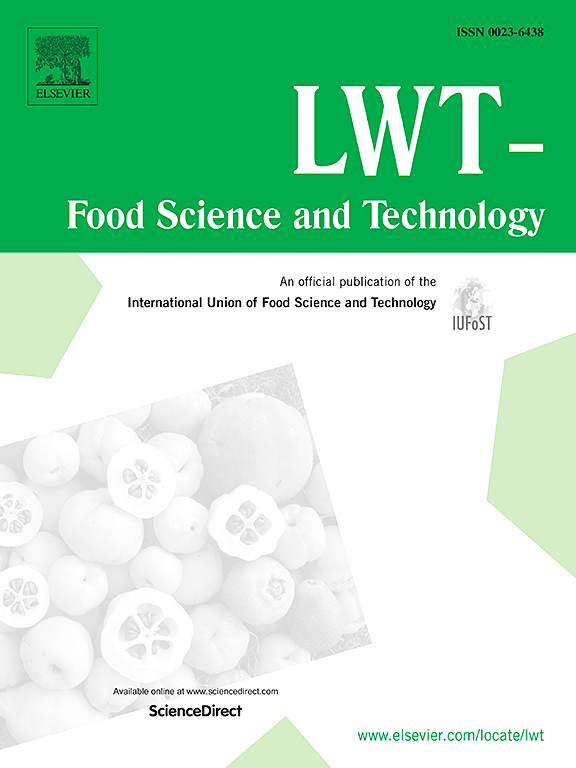超声波辅助提取黑枣中的多糖:优化提取条件、抗氧化活性和结构分析
IF 6
1区 农林科学
Q1 FOOD SCIENCE & TECHNOLOGY
引用次数: 0
摘要
大枣是一种广泛种植的农产品。为了避免资源浪费,提高黑枣的附加值,黑枣在一定的温度和湿度条件下进行加工。目前,对黑枣多糖的研究相对较少。提取方法的选择对植物多糖的研究和利用非常重要。超声波辅助提取技术以其环保、经济、提取率高等优点被广泛应用于多糖的提取。为了充分挖掘黑枣多糖的利用潜力,对黑枣多糖的超声波辅助提取技术进行了优化。根据响应面分析得到的最佳条件,多糖提取率高达 12.75 ± 0.05%。羟基自由基、DPPH 自由基和超氧阴离子的 IC50 值分别为 2.604 mg/mL、0.754 mg/mL 和 8.069 mg/mL。黑枣多糖(BJP)主要由鼠李糖(Rha)、阿拉伯糖(Ara)、半乳糖(Gal)和半乳糖醛酸(Gal-UA)组成,分子量为 1.42 × 106 Da,表面呈致密的网状结构,并有空隙。结果表明,超声辅助萃取能更经济、更高效地提取多糖。本研究中,从黑枣中提取的多糖具有天然抗氧化作用,这可能与多糖中半乳糖醛酸含量高以及超声波可破坏多糖分子链结构有关。作为一种天然抗氧化剂,黑枣多糖在食品和医药行业的功能性产品中具有重要的应用价值。本文章由计算机程序翻译,如有差异,请以英文原文为准。
The polysaccharides from blackened jujube with ultrasonic assistance extraction: Optimization of extraction conditions, antioxidant activity and structural analysis
Jujube is a widely grown agricultural product. In order to avoid the waste of resources and improve the added value of the blackened jujube, the blackened jujube was processed under certain temperature and humidity conditions. At present, there are relatively few researches on polysaccharides of blackened jujube. The selection of extraction method is very important for the study and utilization of plant polysaccharides. Ultrasonic assisted extraction technology has been widely used in polysaccharide extraction for its advantages of environmental protection, economy and high extraction rate. In order to fully tap the utilization potential of polysaccharides from blackened jujube, the ultrasonic assisted extraction technology of polysaccharides from blackened jujube was optimized. Based on the optimal conditions obtained by response surface analysis, the extraction rate of polysaccharide was as high as 12.75 ± 0.05%. The IC50 values of hydroxyl radical, DPPH radical and superoxide anion were 2.604 mg/mL, 0.754 mg/mL and 8.069 mg/mL, respectively. The blackened jujube polysaccharide (BJP) was mainly composed of rhamnose (Rha), arabinose (Ara), galactose (Gal) and galacturonic acid (Gal-UA), with a molecular weight of 1.42 × 106 Da, and the surface was a dense network structure with voids. The results showed that ultrasound-assisted extraction could extract polysaccharides more economically and efficiently. In this study, the polysaccharide extracted from blackened jujube has natural antioxidant effect, which may be related to the high content of galacturonic acid in polysaccharide and the molecular chain structure of polysaccharide can be destroyed by ultrasonic wave. As a kind of natural antioxidant, blackened jujube polysaccharide has important application value in functional products in food and medicine industries.
求助全文
通过发布文献求助,成功后即可免费获取论文全文。
去求助
来源期刊

LWT - Food Science and Technology
工程技术-食品科技
CiteScore
11.80
自引率
6.70%
发文量
1724
审稿时长
65 days
期刊介绍:
LWT - Food Science and Technology is an international journal that publishes innovative papers in the fields of food chemistry, biochemistry, microbiology, technology and nutrition. The work described should be innovative either in the approach or in the methods used. The significance of the results either for the science community or for the food industry must also be specified. Contributions written in English are welcomed in the form of review articles, short reviews, research papers, and research notes. Papers featuring animal trials and cell cultures are outside the scope of the journal and will not be considered for publication.
 求助内容:
求助内容: 应助结果提醒方式:
应助结果提醒方式:


